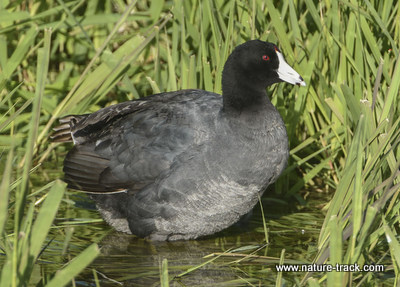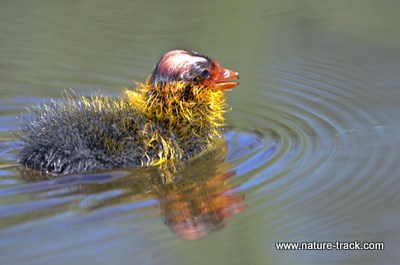Coots


Coots aren’t the most handsome of birds but their success in a changing world deserves respect.
Coot chicks may be inspiration for horror movies but their parents love the gaudy dress.
While voting last week I ran into some friends. They told me that they had taken the advice on my website blog and had gone to Camas NWR to see the sandhill cranes. But what they really wanted to talk about were the American coots they had seen. Both confirmed that they had never seen coots and they were pretty excited about it.
I was stunned. I assumed everyone has seen plenty coots as they are one of the most common birds in our marshes. More, they told me that they had talked to several friends about their experience and the friends confessed that they hadn’t ever seen coots either.
Perhaps I have been a bit presumptuous in assuming everyone knows what a coot is and I will try to remedy that now.
Any waterbody that is lined with reeds such as bulrush and cattail is likely to have coots. It doesn’t matter if you are in Georgia or Washington state. Coots are ubiquitous from coast to coast in suitable aquatic habitats.
Given how widespread and common they are, not realizing you are looking at coots is much more likely than truly not seeing them. Coots are often mistaken for ducks despite the fact that they are in the Rail family and related to sandhill cranes, gallinules and soras.
Coots are all gray-black with white bills and red eyes. The white bill is triangular in cross section as opposed to the flattened bill of a duck and often sports a dark ring near the tip. Coot feet are not webbed like a duck either. Coot toes have lobes that can fold back when the animal is walking but still aid in swimming.
Coots are also gregarious, often forming large loose-knit rafts of birds. Despite their penchant for large groups, watch a group for a while and they will seem like a quarrelsome lot. Bobbing their heads like pigeons, it seems that they have a lot to say about their neighbors, with a lot of cackling, grunting and croaking as they go about their business.
Coots seem to be constantly swimming, sometimes with their young on their back, using the wide lobes on their toes to good effect. Periodically, they dive beneath the surface to reappear about 30 seconds later somewhere else.
Watching coots take flight is much like watching your kid wobble off on his or her maiden bicycle voyage. You want to chase alongside and help them out. Because they are configured to dive, with feet set far back on the body, take-off is a laborious process with the coot running along the water, wings flapping furiously, until the round body can get airborne.
Adult coots won’t win any beauty contests but their chicks could star in horror movies. The little guys have striped red and black bald heads, red bills and feet that seem as big as their bodies. Chest and neck are covered in long yellow or red feather plumes known as chick ornaments.
These plumes seem to be a poor adaptation as they make an otherwise obscure chick very visible. However, research has demonstrated that coot parents play favorites. Chicks with the brightest plumes get the most parental attention.
Because they are so common, coots are often considered a nuisance. Coots deserve more respect than that. Animals that can thrive in this world these days may just be the superstars of the future.

Wildlife License Plates
Great news! as of 2024, there are three NEW designs for license plates. They still are bluebird, cutthroat trout and elk, but they are beautiful.
Idaho Wildlife license plates provide essential funding that benefits the great diversity of native plants and wildlife that are not hunted, fished or trapped—over 10,000 species or 98% of Idaho’s species diversity. Game species that share the same habitats (such as elk, deer, antelope, sage-grouse, salmon, trout) also benefit from these specialty plates.
No state tax dollars are provided for wildlife diversity, conservation education and recreation programs. Neither are any revenues from the sale of hunting or fishing licenses spent on nongame species. Instead, these species depend on direct donations, federal grants, fundraising initiatives—and the Idaho Wildlife license plates.
Both my vehicles have Bluebird Plates. I prefer the bluebird because the nongame program gets 70 percent of the money from bluebird plates, but only 60 percent of the money from elk and trout plates - 10 percent of the money from elk plates supports wildlife disease monitoring and testing programs (to benefit the livestock industry) and 10 percent from cutthroat plates supports non-motorized boat access.
Incidentally, in 2014, the Idaho Legislature denied the Department of Fish and Game the ability to add new plates or even to change the name of the elk and cutthroat plates (very specific) to wildlife and fish plates, a move that would have allowed for changing images occasionally and generating more revenue. It would seem that they believe that we Idahoans don't want a well funded wildlife program.
I think it is time we let the Legislature know that Idahoan support wildlife funding and that we would like to see these generic plates come to fruition.

"WOW. What a phenomenal piece you wrote. You are amazing." Jennifer Jackson
That is embarrassing, but actually a fairly typical response to my nature essays. Since The Best of Nature is created from the very best of 16 years of these nature essays published weekly in the Idaho Falls Post Register (online readership 70,000), it is a fine read. It covers a wide variety of topics including humorous glimpses of nature, philosophy, natural history, and conservation. Readers praise the style, breadth of subject matter and my ability to communicate complex and emotional topics in a relaxed and understandable manner.
Everyone can find something to love in this book. From teenagers to octogenarians, from the coffee shop to the school room, these nature essays are widely read and enjoyed.
Some of the essays here are my personal favorites, others seemed to strike a chord with readers. Most have an important message or lesson that will resonate with you. They are written with a goal to simultaneously entertain and educate about the wonderful workings of nature. Some will make you laugh out loud and others will bring a tear to the eye and warm your heart.
Readers Write:
"You hit a home run with your article on, Big Questions in Nature. It should be required reading for everyone who has lost touch with nature...great job!" Joe Chapman
"We enjoyed your column, Bloom Where Planted. Some of the best writing yet. The Post Register is fortunate to have your weekly columns." Lou Griffin.
To read more and to order a copy, click here or get the Kindle version
Copies are also available at:
Post Register
Island Park Builders Supply (upstairs)
Barnes and Noble in Idaho Falls
Harriman State Park, Island Park
Museum of Idaho
Valley Books, Jackson Wyoming
Avocet Corner Bookstore, Bear River National Wildlife Refuge, Brigham City, Utah
Craters of the Moon National Monument Bookstore, Arco, Idaho